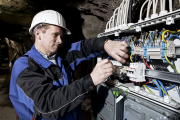 Is positioning as important as specification when planning your electrical housings? A TV property pundit once said that the three most important factors to consider when assessing a building where location, location and location. According to Chris Lloyd, Managing Director of Spelsberg UK, the same adage holds true when choosing where to position electrical enclosures. Here, Chris takes us through the correct decision making process for locating that perfect spot.
Is positioning as important as specification when planning your electrical housings? A TV property pundit once said that the three most important factors to consider when assessing a building where location, location and location. According to Chris Lloyd, Managing Director of Spelsberg UK, the same adage holds true when choosing where to position electrical enclosures. Here, Chris takes us through the correct decision making process for locating that perfect spot.
Electrical enclosure specialists spend a lot of time talking about the best material from which to make enclosures; the optimum cable entry method for particular installations; how to identify the most appropriate IP rating; and any number of other technical issues. But one of the most important decisions for an installer to make is where to put the enclosure. You may think this is a simple matter of common sense, but the sharp-eyed observer regularly spots them in places that could reasonably be described as non-optimum.
So, what should you think about when choosing where to mount an enclosure?
Ease of installation
Most of us will have spent an unhappy few hours bent double trying to fix a leak far under a sink, trying to reach a stop cock that is deep in a dark cupboard, or stretching to a junction box that is just a little too high. Bearing this in mind, ease of accessibility should be high on the list of priorities when deciding where to put an enclosure. It is worth noting that easy access will make the job of mounting easier, faster and less prone to mistakes.
However, it is also important to realise that easy access may be too much of a temptation for someone intent on vandalism, disruption or theft. So, when making an installation in a visible location, a good position is one which is easy to reach but somewhat hidden from general view, or at a height just out of reach but accessible by standing on a step ladder or small stool.
Getting outdoors
Sometimes enclosures must be installed out of doors, typically but not always on an exterior wall of a building. This may mean specifying an IP66 rated or other high-performance enclosure, however it is worth look for options where there is better protection from weather and other environmental stresses. For instance, an investment in 15m of cable may mean you can locate an enclosure in a porch or under a canopy or the eaves of an overhanging roof – and recoup the expense of the cable by using an IP54 box.
If no protection can be afforded it is preferable to fit enclosures on the leeward side of buildings so that they are shielded from the worst of the weather. In such cases a enclosure suppliers will be able to advice on the ingress protection best rating.
Avoiding accidents
While some enclosures will be able to withstand a direct hit from a badly driven forklift truck, most are not designed to be so robust. So, a place that is out of ‘the line of fire’ is a good idea in high traffic areas. It’s not just vehicles you need to be wary of: passers-by, miss-kicked footballs, dropped loads, poorly controlled pallet trucks or shopping trolleys etc, should also be considered – and avoided – where possible.
As a further consideration, locations such as visitor attractions, schools, museums, theatres, restaurant and hospitals, play host to children. In these situations it’s important to think about how tamper proof the enclosures are and to position them well out of reach of curious hands.
… and finally
Very robust enclosures that are able to withstand virtually anything are available, and these should be specified where appropriate. However, with forethought and perhaps some expert advice it may be that a better solution can be found by siting enclosures where they are away from wind and weather and not likely to be damaged accidently or on purpose.


